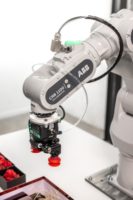Industrial robots are expected to be the focus for investment in factory automation. According to the International Federation of Robotics (IFR), investment in industrial robots is expected to grow at an annual rate of 12% from 2015 to 2017. The packaging industry is experiencing a surge in robotic integration throughout primary, secondary and tertiary packaging—from processing, assembly, labeling and cartoning to case packing and palletizing.
TECH TIPSVision inspection is becoming a critical assistant for many industrial robot applications, providing feedback data about product quality and process capability. As parts and components are handled by robots, various checks and balances are used to ensure that parts and machines are handled in a manner that does not cause damage to the product. Through the use of vision systems, barcode and print detection and verification, such as OCR and OCV, can be used to provide traceability throughout the supply chain. |
The driving force behind the surge in robotics sales growth in North America is the Food Safety Modernization Act (FSMA). The FSMA is requiring companies to introduce automated machinery and components into the production process to help eliminate potential product quality and integrity issues.
With the FSMA about to publicly release its requirements, the use of robots in packaging is at the point of takeoff. And with recent technical advances in robotics helping to power the new wave of interest, companies are experiencing first-hand that robots are faster, smarter and more affordable than ever before.
Complementary to the takeoff of robots in packaging environments, there are a number of technologies that enable robots to be more easily integrated into existing production processes—including vision systems, sensors and real-time network communications. They provide robots with additional capabilities so they can produce higher quality products and improve levels of performance in task-oriented applications.
This article is going to address how robots work with different automation technologies to bring an added element of product quality to what the IFR deems as ‘next-generation industrial environments.’
The biggest pain points for packaging companies operating in today’s rapidly changing industrial environment is the need to handle frequent product changeovers and to run a variety of packaging combinations on a single line, without compromising product quality or integrity. Robots deliver quality-centric benefits to a wide variety of applications.
When it comes to maintaining product quality, it is imperative to look at how industrial robots improve overall equipment effectiveness (OEE) of a production line. By looking at key parameters on a closed, static system—availability, performance and quality—it is not uncommon to see OEE at around 60%. The addition of automated components to that same production line will likely raise OEE to 85% or higher. Robotics, with uptime reliability, are capable of moving products through production faster and with greater accuracy. They ensure high quality products are delivered to the market, making a dramatic difference in competitiveness.
Robots enhance product quality by permitting labor-intensive, repetitive tasks to be accomplished with high speed and accuracy—eliminating errors from manual tasks. This means companies can consistently achieve a high quality finish for every product that exits the production line because industrial robots do not get fatigued and are not affected by heat, dust, humidity and other challenges posed by an industrial environment.
They are not impacted by external environmental factors which can be transferred during production. Robots do not carry pathogens—they do not have skin, hair, fingernails, or bodily fluids such as perspiration, saliva, and blood—that can cause foodborne illnesses. They minimize, if not eliminate, the risk of contamination—the number one cause of compromised product quality.
While robots are becoming an essential part of the packaging industry, companies are looking for additional assurance that their brand, market share and profitability will be protected. Product quality is being driven through a fully-integrated, cooperative system which can respond in real-time to meet changing demands and conditions in the plant, supply chain and in customer needs.
As part of this cooperative system, vision inspection is becoming a critical assistant for many industrial robot applications, providing feedback data about product quality and process capability. As parts and components are handled by robots, various checks and balances are used to ensure that parts and machines are handled in a manner that does not cause damage to the product. An example of how vision systems and robots work together is through package content detection and verification as well as incoming part orientation for package placement.
High consumer expectations regarding product quality as well as traceability requirements imposed by the FSMA mean that packaging companies have a growing need for vision systems that check whether information on a package or label has been applied correctly. Through the use of vision systems, barcode and print detection and verification, such as OCR and OCV, can be used to provide traceability throughout the supply chain. Contaminated products or products with compromised integrity can be identified before they reach the market, eliminating costly potential product recalls.
Advanced sensors also play a key role in this cooperative system, allowing robots to interact with the surrounding production environment. They allow robots to perform all the tasks they are suited for, while offering advanced capabilities to find, identify and manipulate components or products. These capabilities are critical to product quality and integrity, filtering non-conforming products from production. And with the help of real-time network communications, data is simultaneously sent to multiple points on the production line in an effort to correct any identified product or machinery issues.
Robots are generating the need for advanced sensing technology as an inline quality control measure. Sensing has the potential to take robots beyond conventional capabilities to control machinery as well as distinguish product weight, volume, color and appearance. One of the most prevalent ways sensors and robots cooperate is through force. Force sensors are frequently used as a means of sensing applied touch as with a robotic end effector. Used on glass bottling lines to reduce breakage during production, force sensors read sidewall forces applied by the robotic end effector and transmit data so the robot can adjust pressure accordingly.
Another technology driving the takeoff of robotic integration in the packaging industry is the machine automation controller (MAC). It has emerged as a different class of controller, superseding the programmable automation controller (PAC) in the evolution of machine control. When a robot and its integrated components are controlled by a MAC, technologies converge, breaking architectural barriers and contributing to overall equipment effectiveness (OEE).
A MAC is often considered the heart of the robotic system. It integrates robotics, motion, logic, safety and even vision with exacting system synchronization to deliver high performance throughput—on a single controller. It reliably collects production data for analysis and disseminates that data to the appropriate machinery, maximizing uptime and quality, by eliminating points of potential failure. By integrating a MAC, the finished product is guaranteed to be the same every time and any errors or defects are identified by this automated quality control system, thus containing any issues that arise before they reach the market.
When combined with real-time network communications, such as EtherCAT, robotics applications become more attractive for companies. EtherCAT is the emerging network for industrial machine automation, offering fast, accurate and highly efficient data transmission. It is widely considered to be the fastest network on the market.
EtherCAT’s synchronization capabilities and full bandwidth utilization make it ideal for machines that require a high level of uptime. With 40 axes of motion and 2,200 points of inputs and outputs (I/O), the EtherCAT network could have a cycle time as low as 125µs. With high rates of reliability and speed, there is no question that packaging companies can meet their customers’ demands.
The inexpensive, yet high-performance, Ethernet-based fieldbus technology will enable a process or machine to perform at the highest levels of efficiency. Through higher precision and better diagnostic capabilities, EtherCAT will lower equipment costs, help manufacturers produce better quality products, eliminate waste and reduce power consumption.
Delivering on customer expectations of product quality—quickly and cost effectively—is critical for thriving in the packaging industry. Companies are turning to automated machinery and components because they can effortlessly handle variability in next-generation industrial environments. Robotics and other integrated components are changing the packaging landscape by dramatically improving the quality of products reaching the market. Companies can rest assured that their brand, market share and profitability will be protected.




